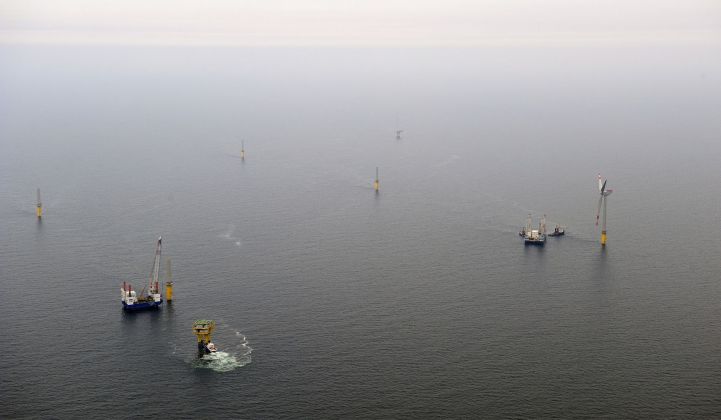A forthcoming study looks set to add to a growing body of evidence suggesting offshore wind farms have a long-term beneficial impact on sea life.
The study, submitted for publication in the aquatic sciences journal Hydrobiologia, concludes offshore wind farm (OWF) turbine foundations in the North Sea could improve biodiversity by providing new homes for the blue oyster, a key marine ecosystem builder.
“The construction of all currently planned, consented and under-construction OWFs, in addition to those already in operation, is likely to increase the overall abundance of blue mussels in the southern North Sea by more than 10 percent,” according to the paper.
“The blue mussel bioengineers its surrounding environment through shell litter fall, water filtration and clarification, [and] concentration of nutrients, ultimately increasing the species diversity and landscape heterogeneity as a result of structural and functional effects," the paper states.
Lead author Kaela Slavik, science officer at Pierre and Marie Curie University’s Future Earth Paris Global Hub, declined to comment on the results pending the outcome of Hydrobiologia’s peer review. “The paper has not [yet] been approved by fellow researchers,” she said.
Once published, though, the research could add further weight to claims that offshore wind farms can act as a haven for marine life.
A 2009 paper in the Journal of Applied Ecology suggested a build out of marine renewable energy infrastructure “will increase the amount of hard substrate in coastal environments” and “may have a significant impact” on biodiversity.
“The presence of novel structures effectively creates new habitat…[and has] consistently been demonstrated to increase both the density and biomass of fish when compared with surrounding soft bottom areas and even local natural reefs,” it said.
The study cited other research showing that turbine monopiles tended to attract a greater number of fish than were in surrounding waters, although the species' diversity was lower.
Helen Bailey, associate research professor at the University of Maryland Center for Environmental Science, said more work is needed to understand the long-term effects of offshore wind on sea life.
“There are many studies in a run-up to a wind farm,” she said, but “building up the amount of information we have post-construction and through operation would be really valuable to understand longer-term impacts -- both negative and positive.”
Research efforts to date have tended to focus on how wind farm construction might affect high-profile marine species, such as dolphins and whales.
Bailey said her own work on the Beatrice wind project in 2006, and that of other researchers, found that marine mammals may choose to avoid areas where construction is underway, but “there has only been one case where they did not return to baseline levels for several years.”
The effect of construction noise on fish has not been studied in Europe, she said. However, the presence of endangered populations of Atlantic sturgeon on the U.S. East Coast might prompt more detailed studies if the American offshore wind market takes off, she noted.
Elsewhere, research is underway to see if the electromagnetic fields from export cables might act as a barrier to fish migration. No effects have been noted so far. Whether offshore wind farms will end up acting as fish havens is nevertheless still open to doubt, said Bailey.
For a start, any sanctuary effect will depend on whether fishing is allowed within the limits of the wind farm. This is not usually the case in Europe but may be so in the U.S. Thus, “the effect may not be equal at all wind farm sites,” Bailey said.
Secondly, she noted, if more fish are observed near a wind farm, does that mean the project is helping to increase stocks or simply attracting them from elsewhere?
The Hydrobiologia research seems to confirm that the former may be true. If so, it might not be a bad idea for the wind industry to seek further confirmation by funding additional independent studies.
“It’s obviously in the companies’ interests to understand those [benefits],” said Bailey.
“There’s been too much focus on ‘Let’s get the information we need for the environmental assessment,’ and then no one pushing on those companies or the government to look at what happens during operation," she said.
--
Come join us for GTM's first annual U.S. Power & Renewables Conference November 7-8. You'll get an in-depth look at how the renewable energy market will interact with the U.S. power market, and how those interactions can impact overall industry development and market growth. Curated by GTM Research, MAKE, and Wood Mackenzie energy analysts, we’ll take an expansive view of key issues and timely topics, bringing together a diverse group of energy experts and stakeholders to discuss demand dynamics, economics and business model shifts, and policy and regulatory implications.




